Porsche 911 Carrera S 991.1 vs. 50th Anniversary Edition 991.1 and Carrera GTS 991.1
Total 911 compares the Porsche 911 991.1 Carrera S, 50th Anniversary Edition and Carrera GTS to find out which is the sweet spot of the last nat-asp 911.1 generation Supertest.
Written by Max Newman
Photography by Max Newman and Ryan Tasker
Performance Icons
C2S V GTS V 50TH ANNIVERSARY: WHICH IS THE BEST NON-GT, RWD 991?
991 Supertest
It’s a battle of the rear-drive 991s as the C2S goes against the GTS and 50th Anniversary Edition
The 991 Carrera range was launched over a decade ago, for the 2012 model year, as the seventh generation of Porsche’s venerable 911. As a ‘clean sheet’ design it heralded one of the biggest generational changes in the model’s history, and signalled both the end of an era and a new beginning. It left behind a legacy as the final naturally aspirated 911 Carrera, because the second-generation 991 Carrera arrived with forced induction four years later.
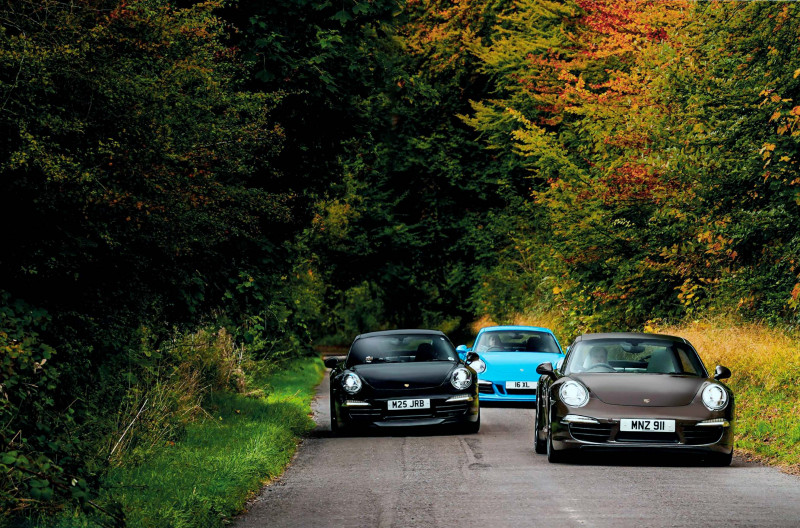
“The extra track width and tyre generate greater stability across the rear”
Criticised for its ever-increasing size and weight, and becoming more GT than sports car, it’s worth noting that the styling of the 991 was fashioned to create an impression of it being wider and lower, but the overall dimensions aren’t greatly different from the 997. It’s slightly longer but no wider, and it’s also lighter – like for like – than the car it replaced.
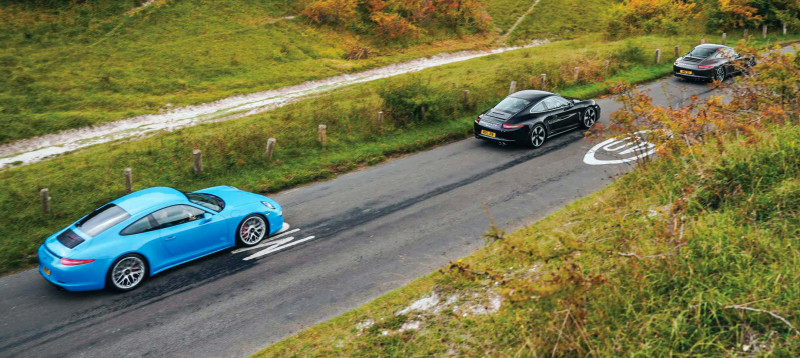
Truly a 21st century 911, Porsche claimed the 991 to be 90 per cent new. It achieved its lighter weight through extensive use of aluminium, and did so despite the wheelbase being increased by 100mm. Of perhaps even greater significance is an increase in the front track of 52mm, which yields a front end more resistant to understeer. As a package the 991 offers a more stable and precise platform, with increased space inside for a sophisticated cabin, which is both modern and unmistakably 911. Greater GT credentials yes, but also potentially more sporting prowess.
“The sound from the engine is at the very heart of this experience”
Power came from a higher-revving development of the 3.8-litre 9A1 engine, which debuted in the Gen2 997 in 2008. In the 991 Carrera S it delivers 400bhp at a heady 7,400rpm before revving out at 7,800rpm. Peak torque was also increased, to 440Nm at 5,600rpm. Further development of the popular twin-clutch PDK gearbox was tackled in-house to deliver snappier shifts – up and down the box – to the enthusiastic driver. A seven-speed manual development of the same gearbox was also offered.
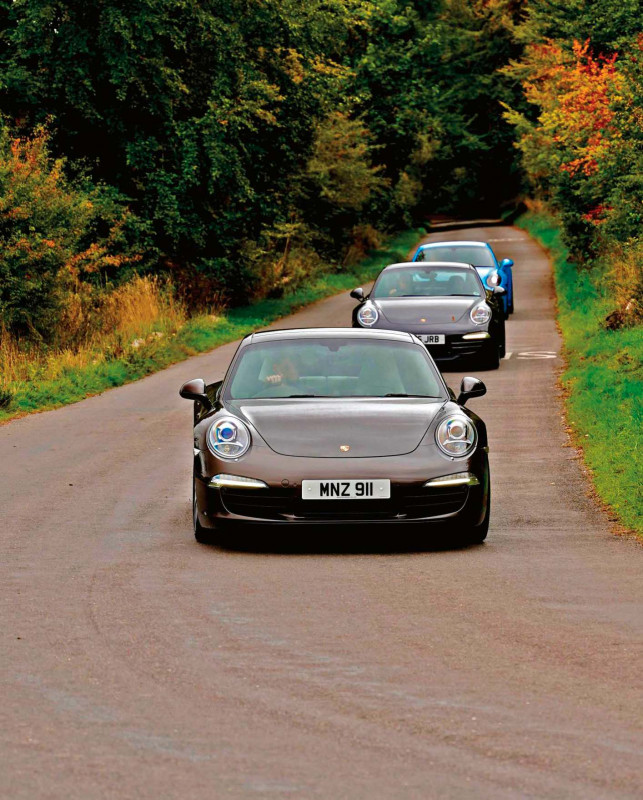
Most controversial of all was the new electronically assisted EPAS steering, which was highlighted for offering a reduced amount of feel through the helm than the previous hydraulically assisted setup. It’s actually rather good; possessed of a calmness not present in hydraulically assisted cars, it enables you to concentrate on the important messages coming from the road.
But this isn’t a Dickensian battle against the ghost of 911s past. Let’s instead explore the 911 Carrera in its most modern, naturally aspirated iteration, before the legislative landscape took it in the direction of smaller capacity, forced-induction engines.
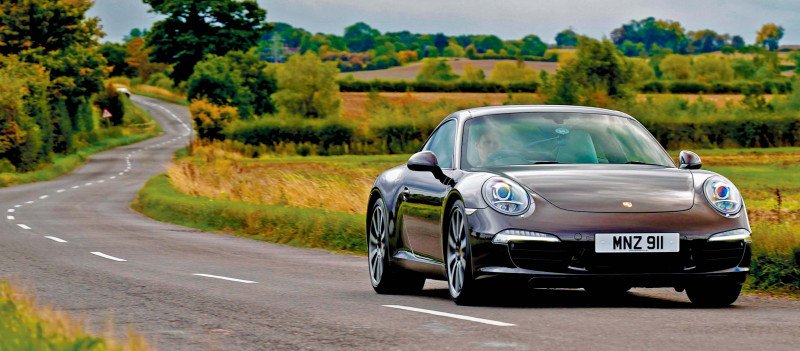
We gathered together three fine rear-wheel-drive examples – a Carrera 2S, the rare 50th Anniversary edition and a GTS – to explore why the car divided opinion so strongly at launch and, against that backdrop, consider what it offers to the discerning 911 enthusiast today.
As our trio of Carrera-based 991s and their owners gather on a bright autumnal morning, snapper Ryan Tasker can’t resist immediately grabbing shots, and the argument that the team led by Peter Varga created what remains a great-looking 911 seems beyond doubt. It makes sense to work in chronological order and begin with the elegant, narrow body Carrera S. Nine years old and with 40,000 miles showing, the car feels tight as a drum, lithe and wieldy as we move down the road in the way only a 911 can.
“The Powerkit motor picks up even more cleanly, is more responsive and reaches for those extra 30 horses at the top of the rev range with real verve”
The PDK ‘box clicks smoothly and quietly through gears as we go. Common to all 991s is a raised centre console running from the PCM unit down the middle of the cabin, which feels modern – aside from the plethora of buttons – and of high quality. Although you have a little more cabin space than in previous 911 generations, it remains an intimate, driver-focused environment. The layout of the instrument binnacle is pure 911.
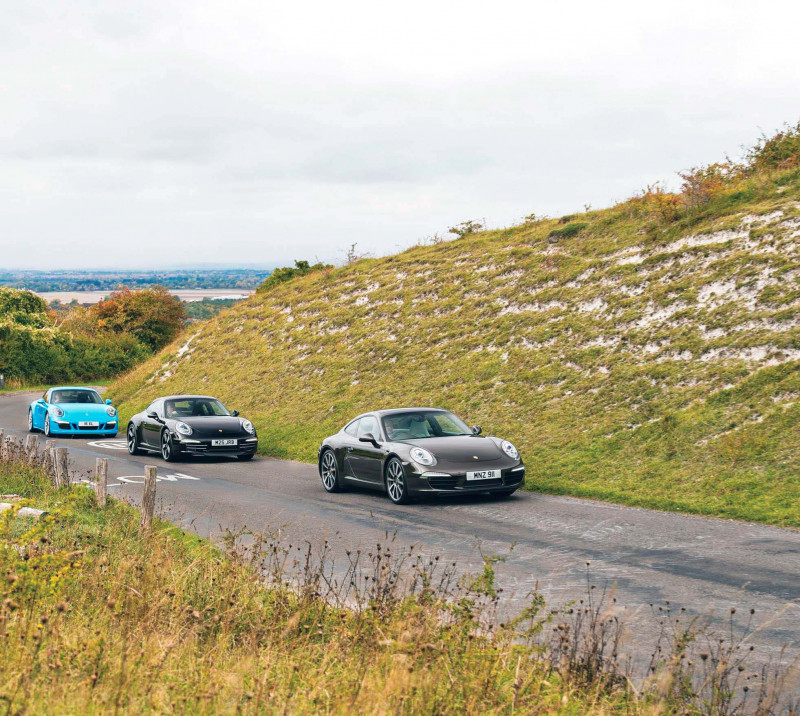
This particular car adds to the sense of occasion with its Agate and Pebble grey two-tone leather interior and a glass sunroof that bathes the already pleasingly bright interior in light – a first for a 911 outside the 993/996/997 Targas. Enjoyed like this, the 991 is refined and the GT credentials of this smart Anthracite brown metallic example seem assured.
We’re in a time before haptics here, and the tower of buttons either side of the gear lever – of which there are plenty in a well-optioned car – can appear confusing to the uninitiated, but actually make sense, fall easily to hand, and operate with a reassuring click. Bringing this myriad of buttons into play sharpens throttle and PDK shift responses with the Sport, or even Sport Plus options on this Sport Chrono Plus-equipped car. A firmer PASM suspension setting settles the rear of the car nicely and is actually usable on British roads; and of course there’s the PSE switchable sports exhaust.
The sound from the engine is at the heart of this experience, and at the centre of the ‘normally aspirated over forced induction’ debate. As the revs build to a crescendo the 991 sounds spectacular – especially from the inside – thanks to the sound symposer, which brings intake and engine sounds into the cabin. It works through a series of chambers and tubes that carry acoustic pulses and mechanical sounds to the passenger rear bulkhead, which in turn acts effectively as a subwoofer. Synthetic sounds piped through the stereo this is not!
The final piece of the puzzle with which to immerse yourself in the driving experience are the up and down shift paddles behind the steering wheel, which are on Sport Design steering wheel-equipped cars. The paddles themselves are metal, cool to the touch, have a satisfying action and add to the intensity of the experience. The gearshift lever itself on a 991.1 Carrera works in the old Tiptronic style unfortunately – forward to shift up – which feels counter-intuitive and doesn’t lend itself to the full DTM (Deutsche Tourenwagen Masters) experience.
As you pick up the pace, the chameleon nature of the 991 reveals itself. The wider front track is precise and resists understeer, but you still have to guide the front of the car towards the apex with some weight over the front axle. As you fire away from the apex and make the most of the inherent traction, the balance between the motor, chassis and tyre (295 at the rear) feels beautifully judged. Agile and exciting, the clarity of feedback in this slim-hipped Carrera S imbues great confidence. It’s a thrilling companion. Be in no doubt that the road manners and character of this car are defined by the location of its engine.
Stepping into the 911 50 Years Edition 991 feels like stepping into an exclusive club of which only 1,963 memberships were available worldwide, and in the UK just 101. Launched in September 2013 to celebrate the golden anniversary of the 911 – hence the production number and nomenclature – the greatest departure from the C2S at face value is the adoption of the wider body from the Carrera 4 and 4S (44mm at the hips), while retaining the rear-wheel drive of the narrow body car. The PASM suspension was subtly recalibrated to complement this increased track width, tyre (305 versus 295) and ability. Other spec highlights included sport seats, Sport Chrono, switchable sports exhaust and PDLS lights, but essentially the ‘50AE’ is all about the details and retro touches. That’s what makes it special.
Riding on special Fuchs-style wheels, the retro vibe continues with high-gloss window frames, chrome trim strips on the front air inlets, the fins of the engine cover grill and on the panel between the rear lights, and a unique badge on the rear lid depicting ‘911 50’. This badging continues inside on the seat headrests, door sills and rev counter. The instruments are a highlight, especially at night. They feature green labelling with white pointer needles and silver caps on the instrument pivot pins, akin to the very earliest 911s. The most important ‘911 50’ badge is on the brushed aluminium cup holder panel, where it’s accompanied by the individual number of each of the 1,963 cars.
Leather is plentiful inside and was available in black or grey, complemented by centres in the Pepita or houndstooth design from the 1960s. It’s a tactile interior that makes you feel that you’re in a car that represents something special.
‘Our’ car, kindly lent by owner and 991 aficionado James Bullen, is number 1,518, finished in black monochrome. This was one of three exterior colour choices, which looks superb against all the 50th anniversary finery. It’s interesting to note that black was an addition by the Porsche marketing department. Famed British Porsche designer Tony Hatter, who created this special model, presented it in Geyser grey – which harks back to some of the earliest 901s – and a darker Graphite grey as a tribute to the iconic 911 driven by Steve McQueen in the film Le Mans. The marketing department insisted on the addition of a black colour option and James’s car, fresh from ceramic coating and PPF, looks immaculate and very cool.
In some markets – the US, for example – the Powerkit was part of the standard equipment on the 50AE, but in the UK it remained on the options list. This particular car doesn’t have it, retaining instead the same 9A1 3.8 and PDK configuration as the C2S, which makes for an even more enticing comparison. As you’d expect, the experience on the road is similar, and the soundtrack equally sensational. In a series of bends the extra track width and tyre generate greater stability across the rear and huge grip. It’s very reassuring, and leaves you convinced you can carry even more speed next time. The overriding impression, contrary to the collectors-only, minimal-mileage approach, is that the 50AE feels so good to be within and inspires such confidence to drive, that I want to head straight for the Eurotunnel and off on a road trip adventure.
Resplendent in PTS Mexico blue, Paul Fairman’s GTS is the final car in our Gen1 991 trio. Launched in autumn 2014, the GTS was a hotly anticipated addition to the 991 range following the success of the 997 variant. The 991 followed a similar recipe by pairing the wider 4S body with a two-wheel-drive powertrain, although the GTS sauce could be applied to other 991 recipes, including the already wide-arched, all-wheel-drive cars, the Cabriolet and Targa variants.
Standard equipment is generous and includes a PASM setup that’s 10mm lower than the other two cars. In addition, and particular to the GTS, are stunning forged-aluminium, centre-lock wheels from the Turbo S – typically finished in black but changed recently to silver on Paul’s car. Other black GTS accents include a grilled air inlet on the rear deck and the strip between the rear lights, although 4WD GTS models retained the red light strip of the 4S. There’s an air of purpose about the interior due to the abundance of Alcantara, which covers the centre panels of the seats, steering wheel, door handles and storage compartments. The sport seats are the best of our trio to sit in. They’re as comfortable as those in the other cars, but more supportive.
Mechanically, all GTS variants were blessed with the Powerkit. Already a finely tuned motor, the Powerkit sought improvements to the 9A1 motor through improved induction and inlet porting, and cams, with mapping to match. Power is increased from 400 to 430bhp and while peak torque remains the same, it’s spread more widely across the curve. It scarcely seems possible, but the GTS sounds even better from the driver’s seat than either the C2S or 50AE. It feels more athletic, too. Faster, although not by a great deal, the Powerkit motor picks up even more cleanly, is more responsive, and reaches for those extra 30 horses at the top of the rev range with real verve.
Chassis-wise, this car confuses slightly by being the only 991 of our trio equipped with optional PDCC (Porsche Dynamic Chassis Control). It’s an electrohydraulic anti-roll bar system utilising hydraulically actuated cylinders to mechanically alter the load on both the front and rear anti-roll bars. Fans of the system say it makes the platform even more stable and brings more responsive handling, while detractors argue it masks some of the feel from the 911’s idiosyncratic layout.
Driven directly after the other two cars, and remembering that it sits 10mm lower on its PASM, the GTS continues to impress with a greater sense of purpose in the way it moves down the road, more firmly albeit perfectly comfortable. The GTS turns in more sharply too, with a clearer response than either the C2S or 50AE. It inspires the same if not even more confidence than the 50AE with which it shares the wider track and rear tyre. The fatter torque curve and Powerkit’s athleticism combine to make you feel as if you’re asking more of it, and it’s rewarding you more in return. Trying to look beyond the variable of PDCC, the GTS is an extremely exciting yet rounded package. It’s the most impressive car here.
The 991.1 Carrera S and its derivatives represent something of a 911 sweet spot. Usefully modern but fizzing with naturally aspirated character, they’re superb cars that should be driven and enjoyed at every opportunity, such is their breadth of abilities. The price point of each car is quite different in the current market. Even so, you could argue convincingly that the GTS is the most sporting of our trio to drive, best to look at, and priced at the midpoint. Therefore, you could say it’s the one to have. And if your budget guides you towards the classically elegant, agile and exciting C2S, you’d justifiably be delighted and wish for nothing more. What of the 50th Anniversary car? You could spend the same money on a 992 C2S and I doubt you’d be any happier or feel more special, be it at your local Cars & Coffee meet, or heading towards an overnight stop in Dijon en route to the Alps. To discount it as an anomaly or collector’s trinket is to miss the point.
LEFT The 50AE’s houndstooth seat inserts are unique to the model and a classy, historical touch
BELOW Green dials contrast nicely against the 991’s modern interior layout
TOP The C2S is the only rear-drive 991.1 in our test to feature the 911’s customary narrow body.
RIGHT MIDDLE With 400bhp, the C2S is the least powerful 911 on test today, but it’s also the lightest.
FAR RIGHT The Agate and Pebble grey two-tone leather interior of the Carrera S is enhanced by a glass sunroof.
LEFT The GTS gave the 991 platform a great standard spec that was optional on the Carrera S, including PSE, Sport Chrono Pack and the 30bhp Powerkit
BELOW A widebody came with both RWD and AWD variants of the GTS, giving this special 991 real presence on the road.


